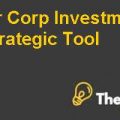Developing a Product Strategy Case Analysis
1. Introduction
Product strategies have often provided companies with strong infrastructural support in the process of both new product development (NPD) and product improvement. Traditional frameworks such as Porter’s Cost-Differentiation model and Ansoff’s Market Positioning are backbones when companies develop product strategies.
In a nutshell, product strategy is the process of delivering the right features and user experience to the right audience. Without a clear product strategy, a business cannot succeed. Product managers must know which products will achieve what goals and prioritize them according to the customer's voice and budget. Product managers should collect insights on customers, analyzing data, and creating brief surveys to get a better understanding of their needs. It is critical to understand the market and buyer's pain points, as well as their lifestyles and spending habits.
However, despite the continuous need for developing successful product strategies, there is very little practical guidance on the procedure and structure, as well as the various factors that play an important role in this area (Bart 1986). Furthermore, there is limited studies that compares product strategies across a wide range of industries. Finally, with the emerging era of digitalization and focus on sustainability, there is little to no research papers that incorporate such technological and socio-economic factors.
1.1 Importance of creating product strategy in a business
The purpose of creating a product strategy is to distinguish your brand or product from competitors. Differentiation does not necessarily have to be about price. It could also be about ground-breaking features or an appealing product's personality. Your strategy should make the product appealing and memorable to customers. The product strategy should involve all the departments, including marketing, sales, and development. It should be based on a thorough understanding of the overall user experience. Many organizations think that adding features will make their products more valuable but end up compromising on the overall user experience. This process is known as "feature creep," which is the opposite of what you want. Once you understand the ultimate experience that customers will have with your product, you can design it to provide that experience.( Souza,2004)
The product strategy is an integral part of your business. It should be available for all employees to view and refer to whenever they are faced with decisions about your company's products. Developing a product strategy keeps your company's vision in the forefront of all decisions. It evaluates your current product, defines the vision, and identifies the needs and wants of your target audience. This process can be tricky if the company is not well prepared for this critical phase.( Meyer,1986)
1.2 Elements of product strategy
The product strategy should include a detailed understanding of your target market, its pain points, and the competitive landscape. The elements of a product strategy will change as the company learns about the market, enters new markets, and becomes more familiar with its competitors. In addition, your product strategy will change as you learn more about the industry and your buyer personas. It's essential to revisit this element of your strategy often.
It should explain the benefits of your new product and its impact on customers. It should also define the product's definition, or what you're building. Once you've developed the definition, your product strategy will serve as your road map to success. In other words, a great product strategy is a road map that specifies your product's features, target audience, and business goals. By developing a detailed product strategy, you'll ensure that your team can complete all the steps necessary to create a successful product.( Dröge,2004)
1.3 Main research problem
The paper highlights the issue related to the ineffective product strategy and their effect on organization. It also highlights how the bad product strategy impact organization profit by ignoring the customer segmentation which are the main assets of the organization.
1.4 Research objectives
The main aim of the research is to analyze the impact of product strategy on the organization. Moreover, the paper aims to develop the importance of effective product strategy and their key similarities and differences across them. Moreover, the main research objective that the review holds followed by research question includes;
1) Capture and learn the “best practices” from literature research and case study interviews
2) Identify important “ingredients or insights” to support execution of product strategy
3) To create a standardized approach for developing a product strategy across a wide variety of industries. (Pichler,2016)
1.5 Research gap
To this date, the process of developing new product strategies have oftentimes been a challenge for many companies. After reviewing the literature, it was determined that while some studies identify the various frameworks and tools that are oftentimes used by companies to develop product strategies, they do not necessarily investigate of how and why those specific frameworks and tools were used and neglects the thought process behind each action.
Furthermore, most research narrow down their scope to one industry, thus, research papers comparing product strategies across a wide range of industries are inexistent. A majority of product strategy studies focus on breadth and not much depth.
Moreover, the paper shows how the impact of sustainability and digital transformation (DX) on product strategy have not been widely explored.( Baker,2006)
To tackle the gaps listed above, this research intends to identify the types of product strategy frameworks used by each company, compare, and contrast the strategy formulation process between companies of similar and different asset-types, and finally create a model approach consistent with all firms.
1.6 Research question
The research aims to answer the following: Which frameworks do companies utilize to develop and optimize their product strategy and are there key similarities and differences across them?
Developing a Product Strategy Case Analysis
This is just a sample partial case solution. Please place the order on the website to order your own originally done case solution.












